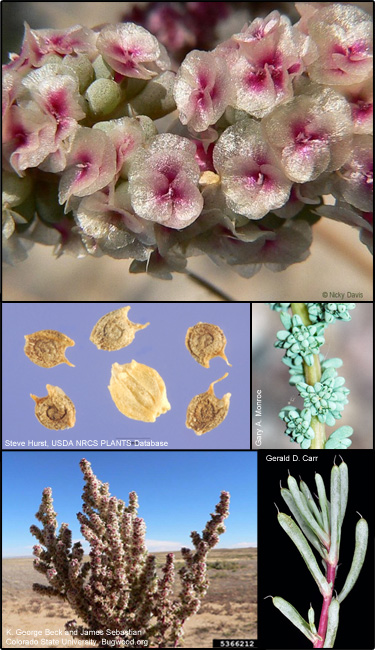Saltlover (Halogeton glomeratus)
 Common Names: Barilla, halogeton
Common Names: Barilla, halogetonDescription: Introduced to the United States in the early 1930s and can be toxic to grazing animals, especially sheep.
Habit: 2-18 in. tall, annual herb.
Leaves: Alternate, sessile, semi-succulent and 0.2-0.9 in. long.
Stems: Curved at the base and reddish to purple in color.
Flowers: Larger flowers are 0.08-0.12 in. wide with 5 light yellow or greenish-yellow sepals and smaller flowers have tooth-like sepals. Neither have petals but both have 2-5 stamens and 2 stigmas.
Fruit and seeds: Produces two types of seeds. Seeds produced in the early summer are light tan in color and wingless, while seeds produced in late summer are dark brown in color and winged.
Habitat: Native to southeastern Russia and northwestern China. Can be found in roadsides, dry lakebeds, shrub lands and other arid or semi-arid regions.
Reproduction: By seed.
Monitoring and rapid response: Introduction of Kochia (Kochia prostrata) has been shown to decress halogetron growth. Biological control using a stem-boring moth (Coleophora porthenica) from Pakistan or a case-bearing moth (Coleophora atriplecivora). Can also be control using 2, 4-D at 2 lbs AI per acre. Credits: The information provided in this factsheet was gathered from the Invasive Plant Atlas of the United States and the US Forest Service FEIS HALGLO.
Individual species images that appear with a number in a black box are courtesy of the Bugwood.org network (http://www.invasive.org). Individual photo author credits may not be included due to the small display size of the images and subsequent difficulty of reading the provided text. All other images appear courtesy of Google (http://images.google.com).
Common Name: | Saltlover |
Scientific Name: | Halogeton glomeratus |
Family: | Chenopodiaceae (Goosefoot) |
Duration: | Annual |
Habit: | Herbs |
USDA Symbol: | HAGL |
